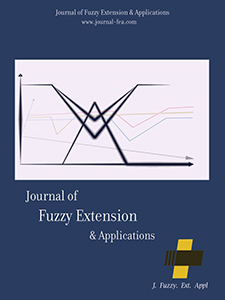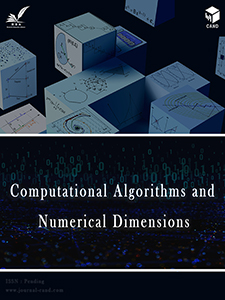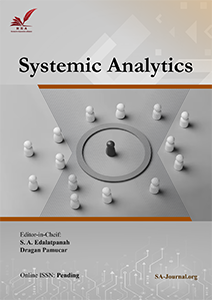Enhancing Possibilistic Fuzzy Goal Programming Approach for Solving Multi Objective Minimum Cost Flow Problems Coefficients
Keywords:
Optimization problem, Minimum cost flow , Multi-objective optimization, Possibilistic variables, Fuzzy goal programming approach, α-possibly optimal solution, Goal programming, Decision maker, Compromise solution, Parametric analysisAbstract
This study investigates a multi-objective minimum cost flow with probabilistic objective function coefficients (Poss- MOMCF). Under using the cut set of the possibilistic variables, the Poss-MOMCF problem is converted into the corresponding ( -MOMCF) and hence into the ( -MOMCF) problem. A necessary and sufficient condition for investigating the possibly optimal solution is established. A fuzzy goal programming approach is applied to obtain the parametric optimal compromise solution. The stability set of the first kid under the concept of possibly optimal solution is characterized and analyzed without differentiability. Finally, a numerical example is given in the sake of the paper to clarify the methodology.
References
[1] Ahuja, R. K., Magnanti, T., & Orlin, J. (1993). Network Flows. Englewood.
[2] Jewell, W. S. (1957). Warhousing and distribution of a seasonal product 1. Naval research logistics quarterly, 4(1), 29–34. DOI:10.1002/nav.3800040107
[3] Slump, C. H., & Gerbrands, J. J. (1982). A network flow approach to reconstruction of the left ventricle from two projections. Computer graphics and image processing, 18(1), 18–36. DOI:10.1016/0146-664X(82)90097-1
[4] Sapountzis, C. (1984). Allocating blood to hospitals from a central blood bank. European journal of operational research, 16(2), 157–162. DOI:10.1016/0377-2217(84)90070-5
[5] Hu, Y., Zhao, X., Liu, J., Liang, B., & Ma, C. (2020). An efficient algorithm for solving minimum cost flow problem with complementarity slack conditions. Mathematical problems in engineering, 2020, 1–5. DOI:10.1155/2020/2439265
[6] Kumar, A., & Kaur, M. (2014). A new method for solving single and multi-objective fuzzy minimum cost flow problems with different membership functions. Sadhana, 39, 189–206. https://doi.org/10.1007/s12046-014-0228-7
[7] Hamacher, H. W., Pedersen, C. R., & Ruzika, S. (2007). Multiple objective minimum cost flow problems: a review. European journal of operational research, 176(3), 1404–1422. DOI:10.1016/j.ejor.2005.09.033
[8] Bazaraa, M. S., Jarvis, J. J., & Sherali, H. D. (2011). Linear programming and network flows. John Wiley & Sons. https://cs.yazd.ac.ir/hasheminezhad/Bazaraa-LP%5B430912%5D.pdf
[9] Steuer, R. E. (1986). Multiple criteria optimization. Theory, computation, and application. https://cir.nii.ac.jp/crid/1573668923835678848
[10] Luhandjula, M. K. (1987). Multiple objective programming problems with possibilistic coefficients. Fuzzy sets and systems, 21(2), 135–145. DOI:10.1016/0165-0114(87)90159-X
[11] Lee, S. M., & Moore, L. J. (1973). Optimizing transportation problems with multiple objectives. AIIE transactions, 5(4), 333–338. DOI:10.1080/05695557308974920
[12] Hemaida, R. S., & Kwak, N. K. (1994). A linear goal programming model for trans-shipment problems with flexible supply and demand constraints. Journal of the operational research society, 45(2), 215–224. DOI:10.1057/jors.1994.26
[13] Tamiz, M., Jones, D., & Romero, C. (1998). Goal programming for decision making: an overview of the current state-of-the-art. European journal of operational research, 111(3), 569–581. DOI:10.1016/S0377-2217(97)00317-2
[14] Romero, C. (2014). Handbook of critical issues in goal programming. Elsevier. https://shop.elsevier.com/books/handbook-of-critical-issues-in-goal-programming/romero/978-0-08-040661-9
[15] Abd El-Wahed, W. F., & Lee, S. M. (2006). Interactive fuzzy goal programming for multi-objective transportation problems. Omega, 34(2), 158–166. https://doi.org/10.1016/j.omega.2004.08.006
[16] Bit, A. K., Biswal, M. P., & Alam, S. S. (1993). An additive fuzzy programming model for multiobjective transportation problem. Fuzzy sets and systems, 57(3), 313–319. DOI:10.1016/0165-0114(93)90026-E
[17] Chanas, S., & Kuchta, D. (1998). Fuzzy integer transportation problem. Fuzzy sets and systems, 98(3), 291–298. DOI:10.1016/S0165-0114(96)00380-6
[18] Chanas, S., Kołodziejczyk, W., & Machaj, A. (1984). A fuzzy approach to the transportation problem. Fuzzy sets and systems, 13(3), 211–221.
[19] Ehrgott, M., & Verma, R. (2001). A note on solving multicriteria transportation-location problems by fuzzy programming. Asia-pacific journal of operational research, 18(2), 149–164.
[20] Aruna Chalam, G. (1994). Fuzzy goal programming (FGP) approach to a stochastic transportation problem under budgetary constraint. Fuzzy sets and systems, 66(3), 293–299. DOI:10.1016/0165-0114(94)90096-5
[21] Lai, Y. J., Hwang, C. L. (1994). Fuzzy multiple objective decision making (pp. 139-262). Springer Berlin Heidelberg.
[22] Büsing, C., Koster, A. M. C. A., & Schmitz, S. (2022). Robust minimum cost flow problem under consistent flow constraints. Annals of operations research, 312(2), 691–722.
[23] Cui, J., An, S., & Zhao, M. (2014). A generalized minimum cost flow model for multiple emergency flow routing. Mathematical problems in engineering, 2014. https://doi.org/10.1155/2014/832053
[24] Hussein, M. L. (1992). On convex vector optimization problems with possibilistic weights. Fuzzy sets and systems, 51(3), 289–294. DOI:10.1016/0165-0114(92)90019-Z
[25] Kassem, M. A. E. H. (1998). Stability of possibilistic multiobjective nonlinear programming problems without differentiability. Fuzzy sets and systems, 94(2), 239–246.
[26] Leberling, H. (1981). On finding compromise solutions in multicriteria problems using the fuzzy min-operator. Fuzzy sets and systems, 6(2), 105–118. DOI:10.1016/0165-0114(81)90019-1
[27] Bellman, R. E., & Zadeh, L. A. (1970). Decision-making in a fuzzy environment. Management science, 17(4), B-141. DOI:10.1142/9789812819789_0004
[28] Zimmermann, H. J. (1978). Fuzzy programming and linear programming with several objective functions. Fuzzy sets and systems, 1(1), 45–55. DOI:10.1016/0165-0114(78)90031-3
[29] Sakawa, M. (1993). Fuzzy Sets and interactive multiobjective optimization. Springer science & business media.
[30] Alharbi, M. G., Khalifa, H. A. E. W., & Ammar, E. E. (2020). An interactive approach for solving the multiobjective minimum cost flow problem in the fuzzy environment. Journal of mathematics, 2020, 1–7. DOI:10.1155/2020/6247423
[31] Ghatee, M., & Hashemi, S. M. (2009). Application of fuzzy minimum cost flow problems to network design under uncertainty. Fuzzy sets and systems, 160(22), 3263–3289. DOI:10.1016/j.fss.2009.04.004
[32] Bustos, A., Herrera, L., & Jiménez, E. (2014). Efficient frontier for multi-objective stochastic transportation networks in international market of perishable goods. Journal of applied research and technology, 12(4), 654–665. DOI:10.1016/S1665-6423(14)70082-3

 Metrics
Metrics



